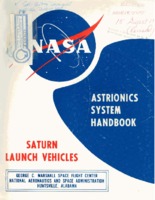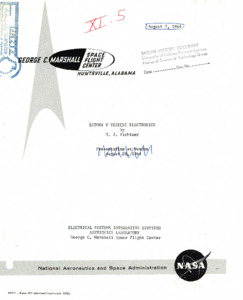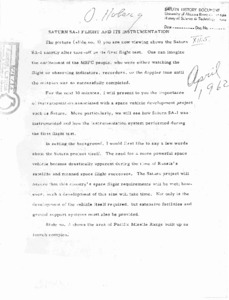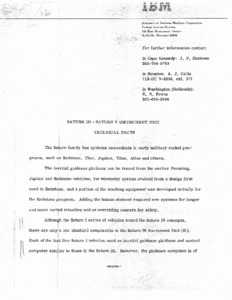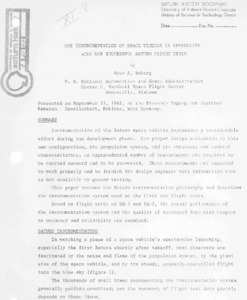
Browse Items (9 total)
Sort by:
-
Saturn Launch Vehicles Astrionics System Handbook, 2nd revised edition.
This updated edition of the Astrionics System Handbook instructs, "The enclosed pages change, delete, or supplement the information in the Astrionics System Handbook (1 August 1965). Insert these pages and destroy the pages they replace." -
Saturn Launch Vehicles Astrionics System Handbook.
Includes change pages. Contract NAS8-14000. Second revised edition. V66-15610. NASA-CR71607. The introduction notes, "This second revised edition of the Astrionics System Handbook has been developed under the direction and overall supervision of Dr. Rudolf Decher of the Astrionics Systems Engineering Office. This description of the Saturn Astrionics System has been generated by personnel of the Astrionics Laboratory, the staff of the Astrionics Systems Engineering Office, and by personnel of the International Business Machines Corporation working under Contract NAS8- 14000. The handbook will be updated and expanded as it becomes necessary due to changes or refinements in the system concept and hardware. Sections not contained in the first release of this document will be made available within three months." Signed by Ludie G. Richard, Chief, Systems Engineering Office, Astrionics Laboratory. The document is missing pages in the following locations: Chapters 8, 9, 12. Sections 15.2, 15.3, 15.4-1 thru 15.4-16, 15.5-1 thru 15.5-2, 15.5-5 thru 15.5-8. -
"Saturn V vehicle electronics."
This presentation is a review of the electrical and electronics systems of the Saturn V launch vehicle. Since airborne and ground electronics cannot be separated as a system, this presentation will touch upon both the airborne and ground checkout equipment. Certain airborne electronic items are singled out in order to elaborate upon the application of computers for checkout and launch. This review covered in a broad sense such airborne electronics as the control computer, the measuring telemetry and RF systems, the switch selector, the digital command receiver and the remote automatic calibration system. The ground support equipment electronics covered include such equipment as the data link, computer system and display systems. The importance of software in the Saturn V program is stressed by the application of a standard program language through the use of acceptance test or launch language (ATOLL). -
"Saturn V vehicle electronics."
This presentation is a review of the electrical and electronics systems of the Saturn V launch vehicle. Since airborne and ground electronics cannot be separated as a system, this presentation will touch upon both the airborne and ground checkout equipment. Certain airborne electronic items are singled out in order to elaborate upon the application of computers for checkout and launch. This review covered in a broad sense such airborne electronics as the control computer, the measuring telemetry and RF systems, the switch selector, the digital command receiver and the remote automatic calibration system. The ground support equipment electronics covered include such equipment as the data link, computer system and display systems. The importance of software in the Saturn V program is stressed by the application of a standard program language through the use of acceptance test or launch language (ATOLL). -
"Saturn SA-1 flight and its instrumentation."
Presentation focusing on empahsising the importance of space programs such as Saturn. -
"Saturn IB - Saturn V instrument unit technical facts."
Press release detailing the technical aspects of the Saturn IB. -
"Saturn instrumentation systems."
Paper to be presented at the Third International Flight Test Instrumentation Symposium College of Aeronautics. A brief description of the Saturn vehicles is given, delineating the makeup of and differences between the Saturn I, Saturn IB, and Saturn V. -
"Saturn IB/V instrument unit."
This brochure provides some basic, general information about the lnstrument Unit, a very important part of the Saturn IB and Saturn V launch vehicles. These launch vehicles are being developed primarily for the Apollo program for manned lunar exploration but will also be used for future space missions. -
"The instrumentation of space vehicle in connection with the successful Saturn flight tests."
Presented on September 21, 1962, at the Eleventh Tagung Der Deutchen Raketen - Gesellschaft, Koblenz, West Germany. Instrumentation sf the Saturn space vehicle represents a considerable effort during the development phase, for proper design evaluatian of this new configuration, its propulsion system, and its structure and control characteristics, an unprecedented number of measurements are required to be carried onboard and to be recovered, These measurements are expected to work properly and to furnish the design engineer with information that is not available by ground testing,
